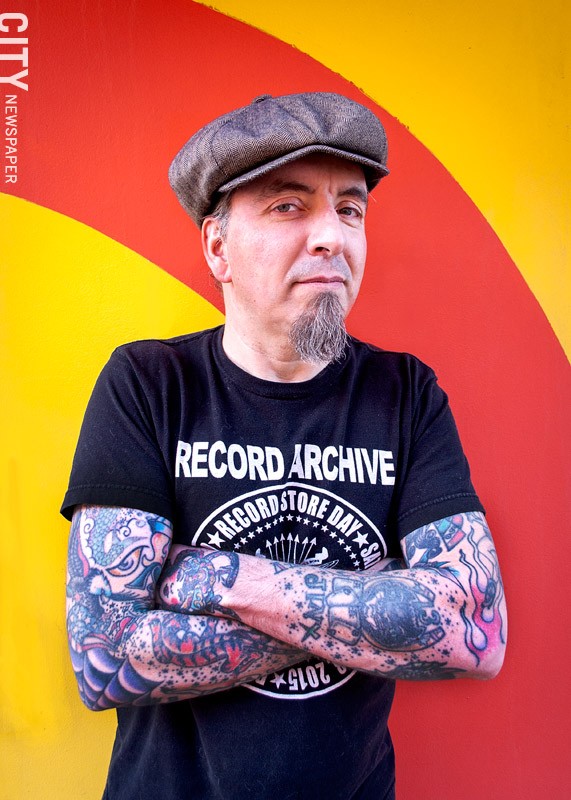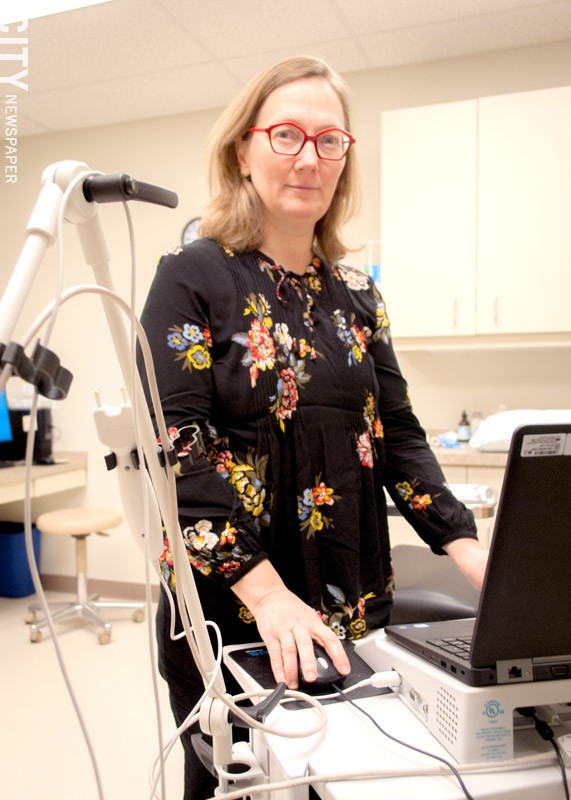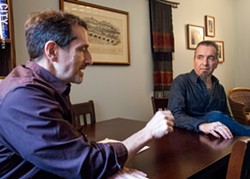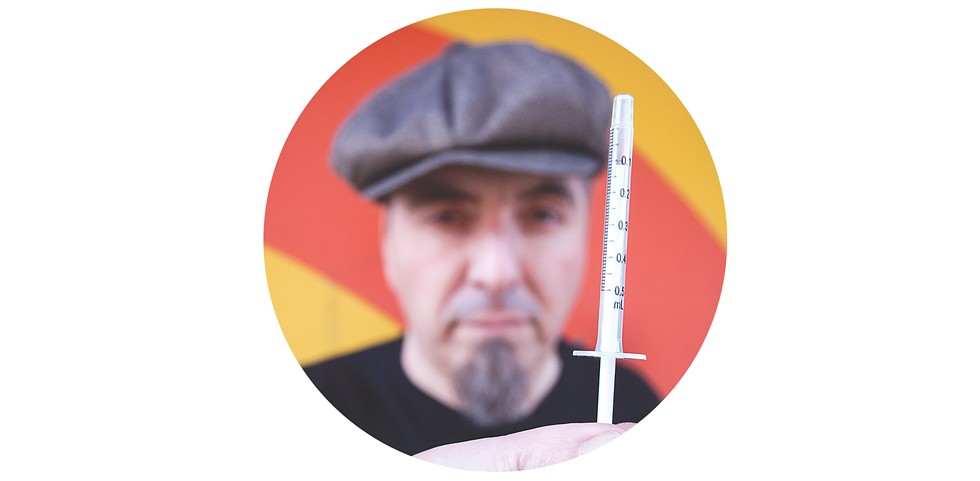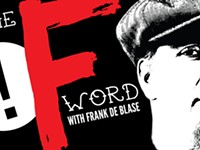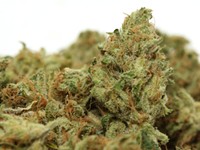
[
{
"name": "500x250 Ad",
"insertPoint": "5",
"component": "15667920",
"parentWrapperClass": "",
"requiredCountToDisplay": "1"
}
]
Security was tight as I strolled into Columbia Care, the medical cannabis dispensary in the Eastman Business Park. I announced myself to the camera outside the first set of frosted glass doors and was buzzed into a vestibule where a woman at the window checked my patient credentials before buzzing me through another set of doors.
A visit to the facility is by appointment only. And, like I said, security was just as tight as the TSA, perhaps even tighter. I would have had better luck sneaking a samurai sword onto a commercial flight. I even had to remove my hat.
Inside, everyone was cordial and quiet, kind of like a futuristic funeral chapel minus the flowers and the stiff. I looked around: everything was white, bright, and sterile. After some paperwork, I was led by a security guard with arms the size of my legs to a room with a counter and people in lab coats ready to fulfill my cannabis wishes and answer my questions. Specifically, I wanted to know if cannabis could combat the symptoms associated with my Parkinson's disease.
New York State recently added Parkinson's disease to its list of eligible conditions for its Medical Marijuana Program. At this point there is little definitive proof of cannabis's positive — or negative — effect on people with Parkinson's disease. It also seems there isn't a lot of research to work with due in large part to the legal ambiguity surrounding the substance. Medical cannabis is legal on the New York State level while on the federal level it remains illegal for both medical and recreational use.
For the last year I've been reading up, harassing doctors, and experimenting with cannabis in various forms. When I decided to pursue this story, I was counting on an avalanche of paperwork, a shit ton of evaluations, and an odyssey of medical uncertainty, legal ambiguity, and politicians and their doublespeak. I was also skeptical.
I talked to doctors who weren't convinced and others that were. I spoke with dispensary operators, state and federal government people, and insurance companies. Man, I had questions.
I wanted to know why there was so little research involving cannabis's effect on Parkinson's disease. I wanted to know how the hell cannabis was listed as a Schedule I drug along with seriously bad dope like heroin and LSD. I wanted to know how cannabis, in certain forms, was legal on the state level yet illegal on the federal and what that actually meant. I wanted to know why cannabis wasn't covered by my insurance provider. But most of all, I wanted to know if cannabis could help me. I dove right in. And I got high a couple of times.
I'm 51 years old, and I have had Parkinson's disease for 17 years. I'm on a regimen of pills and have even had brain surgery in the ongoing battle. And I'm not alone: An estimated seven million to 10 million people have been diagnosed with Parkinson's disease (PD) worldwide, and about 60,000 Americans are diagnosed with the debilitating affliction each year.
PD is a neurodegenerative disease in which brain cells are dying. The main manifestation that the disease is recognized by is the movement problems it causes. It wreaks havoc and frustration; it causes instability and pain — mentally and physically. PD is what's known to some as a "snowflake disease": no two people's symptoms are alike. Everyone who is diagnosed seems to have their own unique set of symptoms. Lucky, huh?
PD messes with my speech and my walking, and I can no longer play the guitar, set a mousetrap, or play "Operation." Yet my symptoms are tame compared to other poor souls with tremors, involuntary movement, falls, and dementia.
My medication doses are relatively low; I don't have to choke down fistfuls of pills. And I don't have tremors or cognitive difficulty (at least I think I don't). I've learned how to manage sharing the same body — my body — with PD. It's like having a 4-year-old roommate living inside me, with cloven hooves and ADD and who always wants to start a tickle fight.
I refuse to allow PD to define me, and I have fought this disease with the love and support of my family — in particular my wife, Deborah — and friends, my own morbid sense of humor, and the guidance of my neurologist, Dr. Michelle Burack.
Over the years, Burack, through careful evaluation along with my input, has prescribed drugs like Carbidopa/Levodopa, Pramipexole, and Amantadine. Carbidopa/Levodopa encourages cells that aren't creating enough dopamine to do so. PD is thought to be caused by too little of this naturally occurring substance in the brain. Pramipexole helps relieve muscle stiffness, but is a risk for causing diminished impulse control and extremes in behavior. And then there is Amantadine which specifically targets dyskinesia (involuntary movement).
Yet nothing that we've done has fixed me ... yet. But we've managed to slow down the progression of my version of PD enough to where it's tolerable. I use that word cautiously. It's a pharmaceutical crap shoot: The pill pendulum routinely swings from ineffective, where I struggle to move, to too effective, where I struggle to keep still. I'm often stuck somewhere in the middle.
It's no secret that I have PD. People started talking about cannabis around me, showing me videos of people in the throes of their affliction one minute, and resting comfortably the next after ingesting cannabis. In one such video you see a man, his arms flailing, until he puts some cannabis tincture under his tongue and within 10 minutes he's still on the couch, watching television.
After anecdotal reports and posts on social media as to cannabis's effect on tremors started to surface, there's been talk of how it could help treat the symptoms of Parkinson's disease. Some researchers have started to think that cannabis might be neuroprotective and able to save neurons from damage caused by PD.
There are two main components in cannabis: Tetrahydrocannabinol (THC), which is associated with the high, and cannabidiol (CBD), which counters that effect some and also offers pain relief and other medicinal properties. Science has proven CBD's benefit.
According to The National Parkinson's Foundation's report "Medical Marijuana and Parkinson's Disease," cannabis contains more than 100 neuroactive chemicals that work with two types of cannabinoid receptors in the body, type 1 (CB1), located in the brain, and type 2 (CB2), located in the brain and peripheral immune system. People with PD have less CB1 receptors than those who don't have the disease. Cannabinoids have powerful, indirect effects on those receptors — but researchers aren't really sure how — and a boost to the receptor from a substance, like the CBD in cannabis, can improve tremors and may alleviate dyskinesia.
Even as a reluctant advocate, I was intrigued. I was determined to try it in addressing my own symptoms and drug-related side effects. Besides, the government is all twisted in a knot, with lawmakers still riding the fence about cannabis's medical, legal, and moral ramifications — now I really had to try it.
Cannabis has been around since dirt was clean. When the mummy of Pharaoh Ramesses II was uncovered and examined in 1881, traces of cannabis were found in the sarcophagus. Traditional texts on Chinese medicine mention cannabis as a treatment for gout, constipation, rheumatism, forgetfulness, and forgetfulness.
While studying in India, in the 1830's, Irish doctor William Brooke O'Shaughnessy documented that cannabis extracts could ease some of the symptoms associated with cholera. By the end of the 19th century, both Americans and Europeans could purchase cannabis extracts at pharmacies to help alleviate assorted ailments, such as stomach aches and migraines. Virtually every patent-applied-for medicine contained tincture of cannabis before the advent of aspirin. And throughout history, hemp was used in everything from sails and rope to paint and clothing, like Levi's.
But in the early-1900's, a shifting political tide and social climate in the US — borne out of racial prejudice and unfounded paranoia toward an influx of Mexican immigrants around the time of the Mexican Revolution — led to vilification of cannabis users. Hatred and bigotry caused Americans to target immigrants, going so far as to vilify cannabis by calling it "marijuana," said to be made by mockingly twisting the Spanish "marihuana" to associate it with the common names "Maria" and "Juan."
"The prejudices and fears that greeted these peasant immigrants also extended to their traditional means of intoxication," wrote Eric Schlosser in a 1994 article for The Atlantic. Schlosser is the author of "Reefer Madness: Sex, Drugs, and Cheap Labor in the American Black Market."
"Police officers in Texas claimed that marijuana incited violent crimes, aroused a 'lust for blood,' and gave its users superhuman strength. Rumors spread that Mexicans were distributing this 'killer weed' to unsuspecting American schoolchildren," Schlosser wrote.
There's also an unconfirmed theory that newspaper tycoon William Randolph Hearst tried to tamp down the use of hemp as it could compete with his vested interest in pulp paper.
Ultimately the Marijuana Tax Act of 1937 made cannabis illegal in the United States. While its medical benefits were known, we became the land of "Just Say No." To this day, there's racial disparity in cannabis: In 2010, black people were nearly four times as likely as whites to be arrested for possession. It's a hard fact that needs to be addressed as legalization pushes across the country.
Today, 29 states and Washington, DC, have legalized medical cannabis, and nine states and Washington, DC, have legalized recreational use. But before you break out Bongzilla, be aware this legalization is at the state level only; cannabis is still considered illegal on the federal level, and forward-thinkers like Attorney General Jeff Sessions are chomping at the bit. The war on drugs rages on.
In 2014, New York became the 23rd state to legalize medical cannabis. And there are still restrictions. In New York, they don't want you smoking herb or eating it in things like gummy bears or brownies. You've got three choices: sublingual tincture, pills, or vapor.
As more states adopt their own medical cannabis programs or fully legalize, politicians have started speaking out more. State Senator Rich Funke, who has stated that he's for the use of medical cannabis when it comes to patients with PTSD, sees through the haze.
"The state needs to do a more efficient job of allowing access for those who need treatment, as patients are currently forced to deal with far too many layers of red tape and bureaucracy," he said.
Politicians on the federal level — where cannabis is still a Class I controlled substance, meaning it can't be used in a medical capacity — are also pushing for change. I spoke with the late Louise Slaughter last year.
"There are a number of bills pending in Congress," she said, "to codify a more relaxed stance on medical marijuana including measures to designate marijuana as a Class III controlled substance."
However, Columbia Care Director Corey Hewitt believes the red tape and bureaucracy will add to the dispensary's legitimacy. Columbia Care opened in Rochester in January 2016.
"Increased regulatory oversight and enforcement benefits Columbia Care," Hewitt said. "We focus on compliance, transparency, compassion, professionalism, and integrity. And we are hyper-focused on providing the highest quality products and service to patients in New York."
Following recreational legalization in California, Washington, and Washington, DC, federal policy changes seem inevitable. Then everyone, both researchers and patients, can experiment in search of benefits, including as they pertain to Parkinson's disease. You can't put the toothpaste back in the tube. You can't unsmoke the joint.
But you'll have to pay for it. Medical cannabis is not covered by insurance. Excellus BlueCross BlueShield VP of Communications Jim Redmond explained.
Medical cannabis isn't a prescription per se — a doctor makes a recommendation for its use — "so it is not covered under health insurance as a pharmacy benefit," Redmond said. Drugs like the anti-nausea medication Dronabinol, which contains THC, are covered because they are prescribed by a physician.
My last visit to Columbia Care cost me $210 for two vapes with cartridges.
Related Columbia Care gets marijuana license for Eastman Business Park

Now, I'm not what you'd consider a heavy pot smoker. I've smoked a few times over the years and generally wasn't all that crazy about it. I don't drink alcohol either. I do have my vices, but that's another story. Still, based on the positive things I was hearing about cannabis's effect on people with Parkinson's, I had to give cannabis a try in a medical context. I approached Dr. Michelle Burack. Citing that she felt there was not enough research, and having more questions than answers herself, she was somewhat skeptical.
"There is so much uncertainty as it is in managing these symptoms," Burack said. "And I'll add something: I don't know what's going to happen because each person is unique. The more I know about what I'm giving, the better I'll hopefully be able to predict what will happen."
It's not that Burack thinks cannabis is bad, she just feels we are in what she calls "an evidence-light zone — almost evidence-free with a couple of little data points." As a layman who doesn't want to sit around just wishing I was better, I was willing to seek out some evidence on my own.
There is a cautionary stance among neurologists like Dr. Peter Schmidt, Chief Research and Clinical Officer of the Parkinson's Foundation.
"There is little formal evidence that cannabis can help people with Parkinson's," Schmidt said, "and some reasons to be cautious about it. Cannabis has a side-effect of executive dysfunction which is the principle effect in recreational use. And people with Parkinson's may want to be cautious about cognitive side effects of medication."
The Parkinson's Foundation has funded research at Columbia University to look at cannabinoid antagonists used in conjunction with the drug Levodopa in an animal model of PD. But "at this point there is not enough evidence to make the call," said Parkinson's Foundation National Medical Director Dr. Michael S. Okun. "Marijuana should never be thought of as a replacement dopaminergic and other approved therapies for PD. However, this leaves open the possibility that cannabinoids may offer some benefit in addition to optimal use of approved therapies."
Burack sent me to see Dr. Robert Horowitz, University of Rochester Palliative Care Division Chief. Horowitz is registered to evaluate patients to see if they're eligible to get their New York State Medical Marijuana Card.
Horowitz is an affable fellow and seems as curious as I am, willing to try whatever his patients are up for. Naturally, he doesn't refute the idea of medical cannabis, but he also has reservations with the limited data."We can't dismiss street level experience," Horowitz said, "so case reports, case studies, testimonials — they matter. It's just hard to draw conclusions. Cannabis is hard to study because it has too many constituents. It's not a single substance."
"One of the misperceptions," he added, "is that there is no science. There's actually a compelling reason why CBD should be effective: it exists in our bodies already. So it makes sense that this is a good therapeutic target."
After a lengthy interview, Horowitz deemed me qualified and set me up with the necessary paperwork. I dreaded what was going to come next as I logged on to the New York State government website. It turns out my panic was unfounded. The process was quick and easy, and within a week I had my Medical Marijuana Card. Horowitz recommended I start with a 1 to 1, equal parts CBD and THC dose for my maiden voyage — a voyage that took me to the Columbia Care dispensary.
Two forms of ID, my evaluation letter from a doctor, and a quick sashay through several doors that closed themselves behind me; I was in the sanctuary.
I was waited on at the counter by a nice young woman in a lab coat who spoke in a pleasant, measured voice. The first thing I noticed was how she avoided slang, especially words like "stoned" and "high," replacing them with the more subdued "the high some people experience," as if it were an unwanted side effect.
It was clear they weren't selling any kind of high, but were instead focusing strictly on the medicinal benefits of their product. Not one to censor myself, I made it clear: I didn't want to get fucked up, like some people experience. I was looking to see if cannabis could ease my symptoms of Parkinson's disease, not spend hours wondering if my fingers could fing or waiting for the shuttle to land.
My personal plan of attack was to address the problems with my speech, with its stuttering and slurring. My walking had inexplicably improved (up until a year ago I relied on a cane), but the vocal inarticulation persisted. It was especially severe when I was experiencing what is known as "on" time, where my medication was at its maximum effectiveness with the side effects on full as well.
Now, I need my prescribed meds or I can hardly move. So I figured the medication would attack the PD and the cannabis would calm the side effects of the drugs. I'd be campaign shouting like a Southern diplomat in no time.
I bought a two-week supply of tincture. As soon as I got home, I squirted it under my tongue and held it there as I had been instructed by the woman in the lab coat. It tasted like I was licking the ashtray of a VW Microbus — but it did nothing other than that. I tried again the following four days and felt a little twinge once ... I think. But nothing earth-shattering. Porky Pig remained.
The next month, I ramped up my research two-fold. I bought a vape and ordered a high THC to CBD, 20 to 1, cartridge of vaporization oil. There was still some CBD and Horowitz had told me the two components seemed to work in tandem anyway.
The problem with the vape, besides looking like I was sucking a screwdriver, was its smooth delivery. Rather than the donkey kick you get in the chest when smoking a joint, the vape delivered its product so cool and smooth that you don't feel like you're getting anything, so you hit it harder.
It's only when you exhale a huge, low-lying cumulus cloud that you realize, holy shit, that "high that some people experience" is on its way, along with fucked up. This is where I found myself. In trying to combat my disease I had created a new paradigm: Parkinson's plus stoned. The next few hours were no fun.
Researching this story proved to be relatively easy. I ran into none of the resistance I had anticipated. The doctors were helpful, the politicians were forthcoming and eager and even the health insurance representatives dispelled some myths.
But it was also disappointing.
Not that I couldn't find a cure — the cure — but the fact that I probably ended with new questions, different than the ones I started out with. I spent roughly six months testing medical cannabis, increasing and decreasing doses and methods of delivery — tincture, vape, gummy bears, and just firing up a regular old joint. I tried to pinpoint when my body was the most receptive. It was like shooting at a moving target.
But I don't want to disparage anyone who has found benefit in treating their Parkinson's disease with medical cannabis or discourage somebody looking to try it for the first time. There's definitely potential there. It just needs to be realized and researched more.
It'll be interesting to see what happens when recreational cannabis is approved in all states. It's simply a matter of time. In Colorado, for example, cannabis shops in 2017 brought in $1.5 billion in sales. Who's going to say no to that? And by 2019, pot will outsell beer in California.
And to all the Parkinson's sufferers, don't give up hope. Anyone who's suffered a disease like this knows the power of hope — the intoxicating allure of "could be" and "maybe." You want it so bad you can taste it. You begin to believe it's working.
Cannabis affected me, just not in the way I had imagined. That's not to say it won't deliver the desired results for patients with myriad ailments and pain, nor am I necessarily done with cannabis myself.
Back when I was first diagnosed, I asked one of my neurologists, "Am I going to die?"
"Absolutely," he said. "But not from this."
